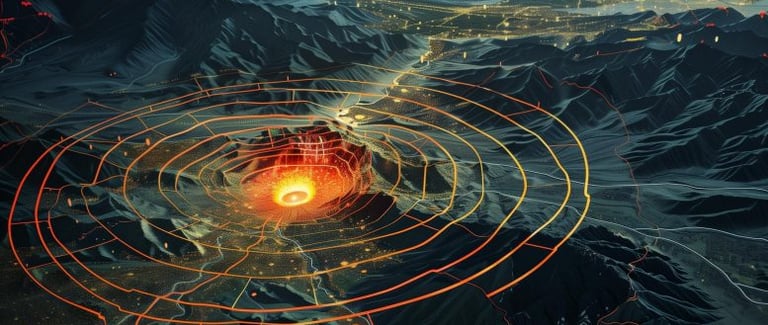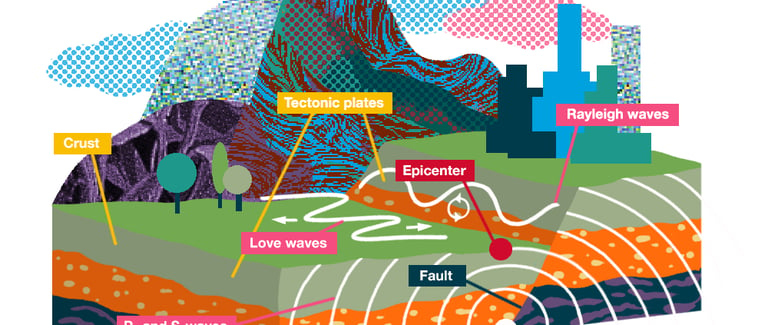Do You Know the Hidden Science Behind Earthquakes
#earthquake, #tectonicplates, #earthsciences, #seismology, #naturaldisasters, #plateboundaries, #geologyfacts, #earthquakepreparedness, #safecities, #globaldisasters
TECH & SCIENCE
7/26/20253 min read




Shaking the Earth—A Natural Wonder or a Hidden Force?
Earthquakes have always fascinated and frightened humanity. From ancient legends about angry gods to modern seismic sensors and satellites, the way we understand earthquakes has evolved tremendously. But do you really know what causes the earth to shake? What hidden forces operate beneath our feet? Let’s explore the deep, mysterious science behind earthquakes—one of nature’s most powerful phenomena.
1. What Is an Earthquake?
An earthquake is a sudden and rapid shaking of the ground caused by the movement of rock beneath the Earth’s surface. This movement occurs because of tectonic forces—massive plates of Earth’s crust and upper mantle floating and grinding against each other.
Most earthquakes happen along these tectonic plate boundaries, where plates either collide, slide past, or move apart. These interactions build pressure, and when that pressure is released, the energy radiates outward—causing the ground to shake.
2. The Earth's Layers and Fault Lines
To understand the science behind earthquakes, it's essential to know Earth's internal structure. The Earth has:
Crust: The outermost solid layer where we live.
Mantle: A hot, flowing layer of semi-solid rock.
Outer Core: Liquid metal layer.
Inner Core: Solid metal core, mainly iron and nickel.
Earthquakes occur in the crust and upper mantle, particularly along fault lines, which are fractures between blocks of rock.
The most famous fault line in the world?
➡️ The San Andreas Fault in California, USA.
3. Types of Plate Boundaries and Their Earthquakes
There are three main types of tectonic plate boundaries, each producing different earthquake behaviors:
Convergent Boundaries (Collision Zones):
Where plates move toward each other, like India colliding with Asia, forming the Himalayas and causing powerful quakes.Divergent Boundaries (Spreading Centers):
Where plates move apart, like in the mid-Atlantic ridge, creating underwater earthquakes and new crust.Transform Boundaries (Sliding Past):
Where plates slide horizontally past each other, like the San Andreas Fault—famous for severe, sudden jolts.
4. What Causes the Ground to Shake?
The stored energy from stress builds up along fault lines. When the stress exceeds the rock’s ability to withstand it, the rock fractures and slips, releasing energy in the form of seismic waves.
There are three types of seismic waves:
P-Waves (Primary): Fastest, travel through solids and liquids, compressing and expanding material.
S-Waves (Secondary): Slower, only move through solids, shaking the ground side to side.
Surface Waves: Slowest, but most destructive, traveling along Earth’s surface.
5. How Earthquakes Are Measured
Earthquake strength is measured in two key ways:
Magnitude (Richter Scale / Moment Magnitude Scale - Mw):
Measures the amount of energy released. Each whole number increase (e.g., 6.0 to 7.0) means 32 times more energy.Intensity (Modified Mercalli Intensity Scale):
Describes how it felt on the surface, from "Not felt" (I) to "Extreme" (XII).
6. Deadliest Earthquakes in History
Some earthquakes have caused immense devastation:
1556 Shaanxi, China:
Estimated magnitude 8.0; over 830,000 deaths.2004 Indian Ocean Earthquake and Tsunami:
Magnitude 9.1; over 230,000 deaths across 14 countries.2010 Haiti Earthquake:
Magnitude 7.0; over 160,000 deaths due to poor infrastructure.
These tragedies reveal that it’s not just the magnitude, but population density and preparedness that determine damage and loss.
7. Can We Predict Earthquakes?
Unfortunately, earthquakes cannot be precisely predicted. Scientists can forecast risk based on seismic history and fault activity but cannot give exact times and places.
However, new technologies like AI-driven prediction models, satellite monitoring, and machine learning on seismic signals are showing promise.
8. Modern Tools and Earthquake Science
Today, we use:
Seismometers and Seismographs to detect vibrations.
GPS Systems to measure ground movement.
Drones and Satellites to survey damage post-quake.
Earthquake Early Warning Systems, like in Japan, which can alert seconds before shaking reaches an area.
Japan, Mexico, and parts of the US already use these systems to reduce casualties.
9. How to Stay Safe During an Earthquake
Knowing what to do can save lives:
Drop, Cover, and Hold On!
Stay indoors and away from windows.
Avoid elevators and unstable furniture.
After shaking, expect aftershocks.
Preparation includes:
Earthquake-resistant buildings.
Emergency kits.
Family communication plans.
Conclusion: Earthquakes Are Inevitable—But Disaster Doesn’t Have to Be
While we can’t prevent earthquakes, we can reduce their impact through science, preparation, and global cooperation. By understanding the forces below our feet, we can build smarter cities, save lives, and appreciate the incredible power of our living planet. So, the next time the ground shakes—know it’s Earth’s ancient science in motion.
Knowledge
Empowering minds with reliable educational content daily.
Newsletter Signup
© 2025 DoYouKnow. All rights reserved.
Stay Ahead of the Trends – Join Our Newsletter
